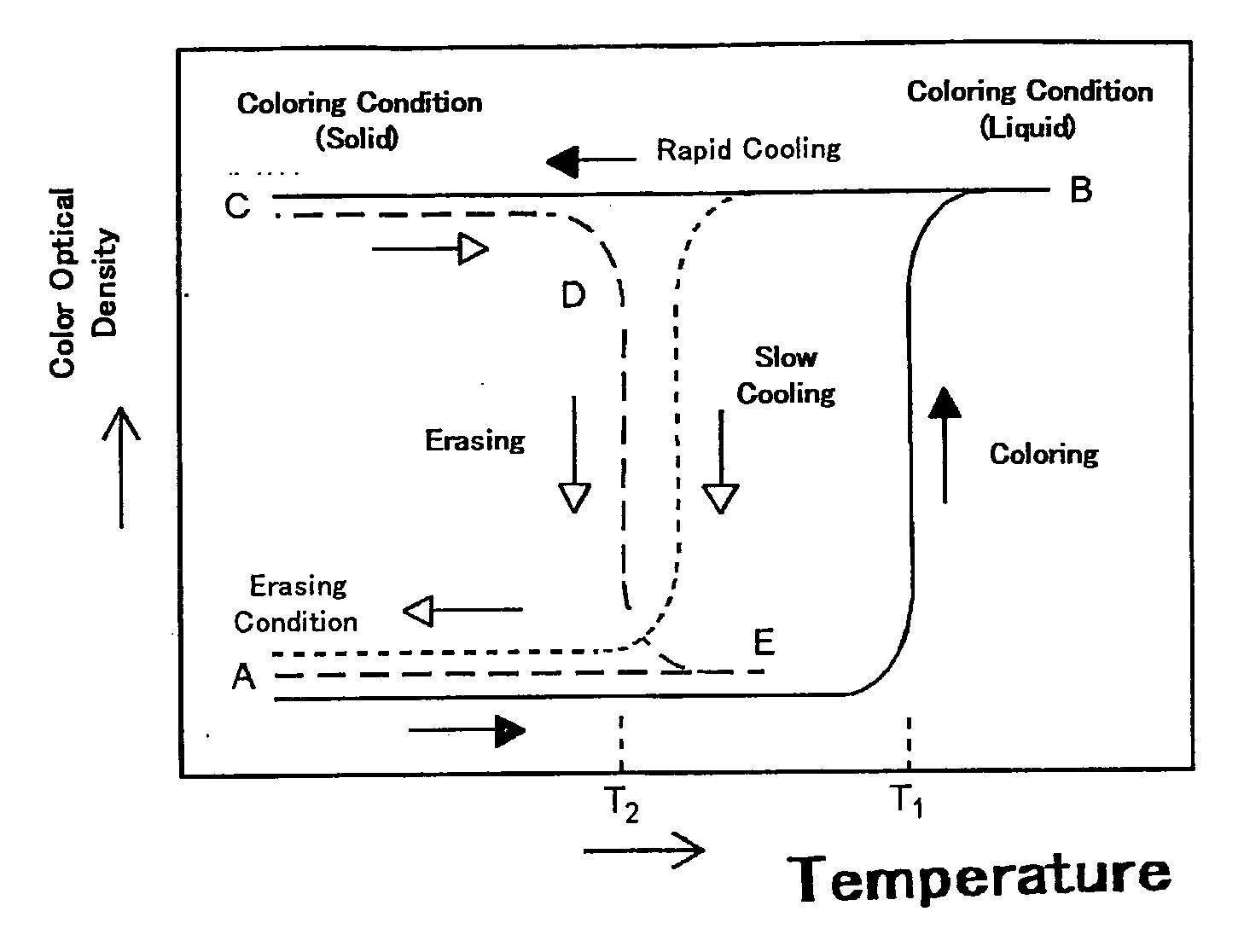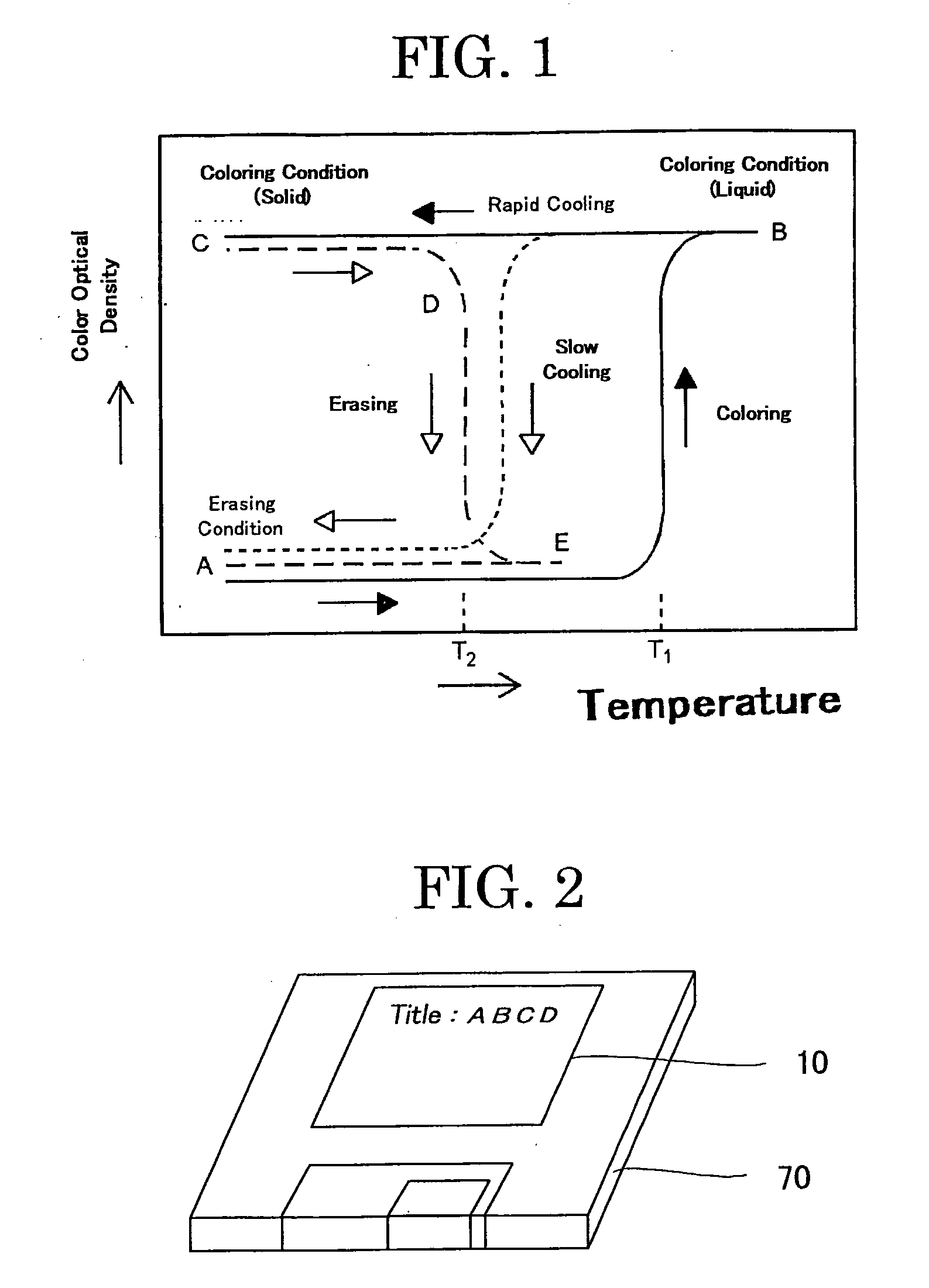Phenol Compound, Reversible Thermosensitive Recording Medium, Reversible Thermosensitive Recording Label, Reversible Thermosensitive Recording Member, Image-Processing Apparatus and Image-Processing Method
a technology of phenol compound and recording medium, which is applied in the field of new phenol compound, can solve the problems of limited total area capable of being recorded, inability to erase recorded images, and inability to be used repeatedly, and achieve excellent heat resistance and preservation of image parts, and satisfactory coloring sensitivity.
- Summary
- Abstract
- Description
- Claims
- Application Information
AI Technical Summary
Benefits of technology
Problems solved by technology
Method used
Image
Examples
example 1
A Synthetic Example of Color Developer Expressed by Following Structural Formula
[0214]
[0215]First, 200 mL of toluene and 13.3 g of lignoceric acid were added to a reaction container and 8.6 g of thionyl chloride was further added and heated to reflux for 8 hours. The solvent and thionyl chloride were distilled away under reduced pressure using an evaporator. 100 mL of acetone was added to the obtained acid chloride compound and stirred with ice application. An aqueous solution into which 3.5 g of sodium azide was melted was gradually added not to exceed a temperature of 10° C. and further stirred for 2 hours. The obtained reaction solution was extracted with toluene and washed and after it was dried with magnesium sulfate and transferred to the reaction solution, it was then heated at 80° C. of inner temperature. After nitrogen generation was completed and generation of isocyanate compound was confirmed, 3.5 g of p-aminophenol was added to the reaction solution, heat stirred for 1 h...
example 2
A Synthetic Example of Color Developer Expressed by Following Structural Formula
[0216]
[0217]First, 100 mL of toluene and 5.4 g of pentacosanoic acid were added to a reaction container and 3.4 g of thionyl chloride was further added and heated to reflux for 6 hours. The solvent and thionyl chloride were distilled away under reduced pressure using an evaporator. 150 mL of acetone was added to the obtained acid chloride compound and stirred with ice application. An aqueous solution into which 1.4 g of sodium azide was melted was gradually added not to exceed a temperature of 10° C. and further stirred for 1 hour. The obtained reaction solution was extracted with toluene and washed and after it was dried with magnesium sulfate and transferred to the reaction solution, it was then heated at 80° C. of inner temperature. After nitrogen generation was completed and generation of isocyanate compound was confirmed, 1.5 g of p-aminophenol was added to the reaction solution, heat stirred for 1 ...
example 3
A Synthetic Example of Color Developer Expressed by Following Structural Formula
[0218]
[0219]First, 250 mL of toluene and 12.0 g of cerinic acid were added to a reaction container and 7.2 g of thionyl chloride and a few drops of DMF were further added and heated to reflux for 8 hours. The solvent and thionyl chloride were distilled away under reduced pressure using an evaporator. 100 mL of acetone was added to the obtained acid chloride compound and stirred with ice application. An aqueous solution into which 2.9 g of sodium azide was melted was gradually added not to exceed a temperature of 10° C. and further stirred for 3 hours. The obtained reaction solution was extracted with toluene and washed and after it was dried with magnesium sulfate and transferred to the reaction solution, it was then heated at 80° C. of inner temperature. After nitrogen generation was completed and generation of isocyanate compound was confirmed, 3.3 g of p-aminophenol was added to the reaction solution,...
PUM
| Property | Measurement | Unit |
|---|---|---|
| hydroxyl value | aaaaa | aaaaa |
| temperature | aaaaa | aaaaa |
| hydroxyl value | aaaaa | aaaaa |
Abstract
Description
Claims
Application Information
 Login to View More
Login to View More - R&D
- Intellectual Property
- Life Sciences
- Materials
- Tech Scout
- Unparalleled Data Quality
- Higher Quality Content
- 60% Fewer Hallucinations
Browse by: Latest US Patents, China's latest patents, Technical Efficacy Thesaurus, Application Domain, Technology Topic, Popular Technical Reports.
© 2025 PatSnap. All rights reserved.Legal|Privacy policy|Modern Slavery Act Transparency Statement|Sitemap|About US| Contact US: help@patsnap.com



